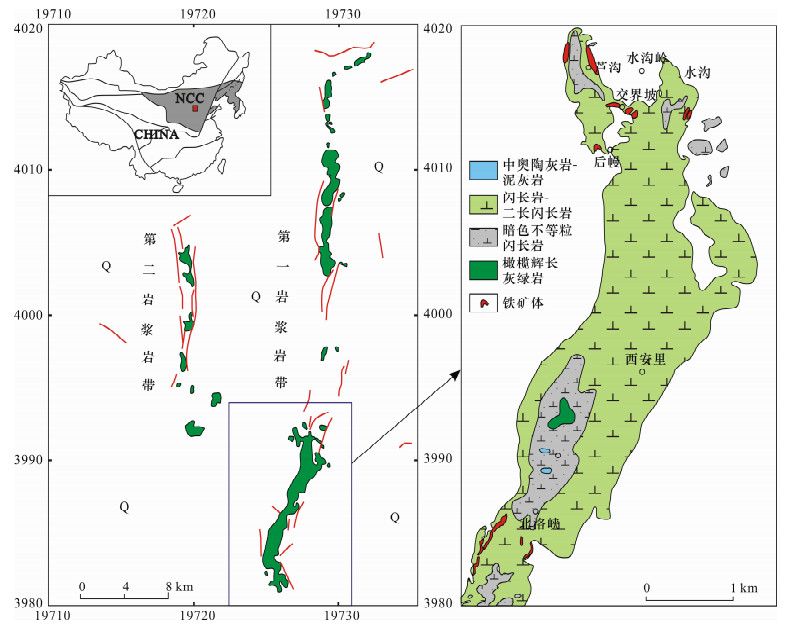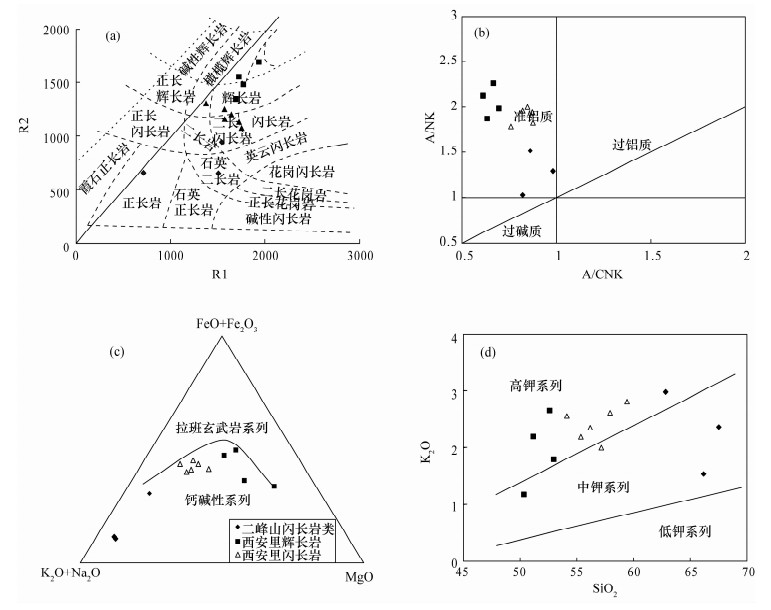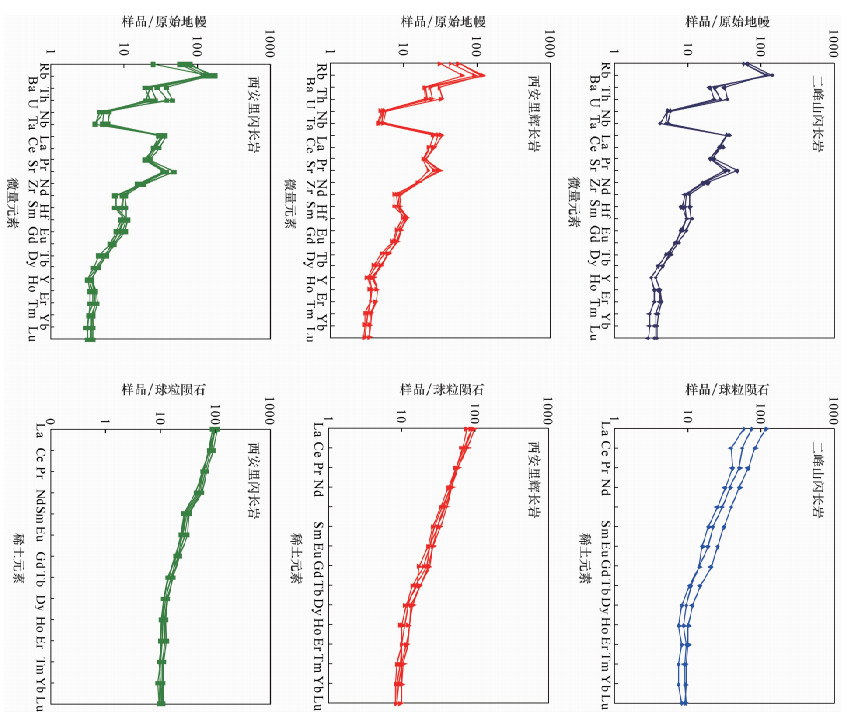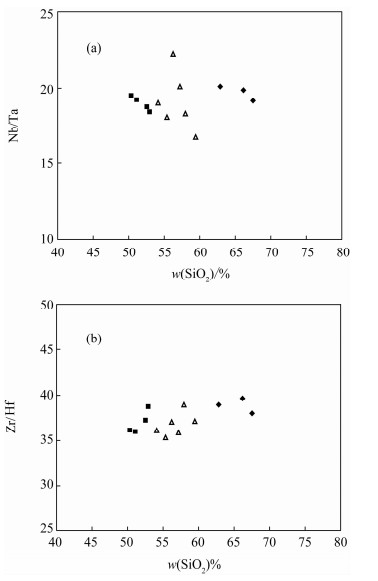Chronology and Geochemistry on Mesozoic Diorite from the Xi′anli Iron Ore Area in Pingshun, Shanxi Province
-
摘要: 山西平顺地区位于大型宽缓的太行山复式背斜的西翼,大地构造位置属吕梁-太行断块的太行块隆的东南部,是华北地区重要的矽卡岩铁矿矿集区,中生代闪长质岩石是本区矽卡岩型铁矿重要的成矿母岩。本研究对其进行锆石SHRIMP年龄测定和地球化学分析,结果显示辉长岩和闪长岩的锆石年龄分别为123 Ma和126 Ma,两者侵位时代基本一致。地球化学分析显示区内岩浆岩主要为准铝质高钾钙碱性系列岩石,所有样品(二峰山闪长岩、西安里辉长岩和闪长岩)均有非常相似的稀土配分模式,富集轻稀土元素(∑LREEs平均值分别为94.64 μg/g、110.73 μg/g、118.63 μg/g),轻重稀土分馏不是很强烈,(La/Yb)N平均值分别为9.47、9.17、9.70;Eu异常不明显(δEu平均值分别为1.00、0.96、1.04),富集Ba、Th、U等大离子亲石元素,具有高Sr特征,所有岩性强烈亏损Nb、Ta等高场强元素。研究认为岩体主要来自幔源岩浆与壳源酸性岩浆的混合作用,样品高的Nb/Ta(17~22,平均19)以及Zr/Hf值(35~40,平均37)是继承了岩浆源区高Nb/Ta和Zr/Hf比值特征,表明地幔源区受到俯冲板片熔融体/流体的交代。其地球动力学背景为华北克拉通中生代破坏和岩石圈减薄事件,但是应该注意华北克拉通破坏和岩石圈减薄机制的多样性。Abstract: The Shanxi Pingshun region is located in the west limb of a large-scale anticline of Taighang Mountain and is to the southeast of the Taihang upwell of Lüliang-Taihang fault block. It is one of the most important skarn iron ore concentration areas in North China. The Mesozoic dioritic rock was the source rock for skarn Fe deposits. In this paper, the work carried out on zircon SHRIMP dating and geochemical analysis of Mesozoic magmatic rocks is described. The results of zircon ages for the gabbro and diorite were 123 Ma and 126 Ma, respectively (within the same intrusion periods). Magmatic rocks in the region were metaluminous high-K calc-alkaline series rocks and all the samples (Erfengshan diorite, Xi′anli gabbro and diorite) were characterized by similar REE patterns with enriched LREE (ΣLREE on average is 94.64 μg/g, 110.73 μg/g and 118.63 μg/g). The fractionation between LREE and HREE was not very strong since (La/Yb)N on average were 9.47, 9.17 and 9.70. The Eu anomaly was not obvious as δEu on average were 1.00, 0.96 and 1.04. The gabbro and diorite were enriched Ba, Th, U, and other LILEs had the characteristic of high Sr and strongly depleted HFSEs (Nb, Ta). Combined with previous research results, indications are that the magmatic rocks were mainly from the mixing members between mantle-derived magma and the low crust-derived magma. High Nb/Ta (17 to 22, on average is 19) and Zr/Hf values (35 to 40, on average is 37) were inherited from the magmatic source features. This indicated that the mantle source was replaced by subducted slab melt/fluid. The geodynamic setting is Mesozoic destruction and a lithospheric thinning event in the North China Craton. However, the diversity of the mechanism should also be noted.
-
Keywords:
- North China /
- iron ore /
- mesozoic /
- diorite /
- SHRIMP U-Pb dating /
- geochemical characteristics
-
华北克拉通中生代大规模的岩浆作用具有一些明显的地球化学特征,岩浆岩以中酸性和酸性为主,伴有少量的基性侵入岩和火山岩,具有高钾钙碱性、高Sr-Ba含量、高Sr/Y和La/Yb比值、高度富集Sr-Nd同位素特征[1-12],对于中生代岩浆岩形成的机理有研究者认为是由基性下地壳在加厚地壳背景下发生部分熔融的结果[13-14],也有人提出了壳幔岩浆混合作用的成因机制[11, 12, 15-17]。这两种机制有什么明显不同?太行山造山带是华北克拉通东部中生代重要的一条岩浆岩带,发育大量的中酸性岩体,出露少量的基性小岩体,这些中酸性岩体的主要侵位时代是127~138 Ma(锆石U-Pb)[18]。山西平顺地区中生代岩浆岩位于太行山岩浆岩带西南部,且控制了该地区矽卡岩型铁矿床的成矿作用,长期以来对这些岩体相关研究较少;二峰山铁矿是晋南地区重要的矽卡岩型铁矿床,位于平顺地区以西150 km,矿体赋存于燕山期岩浆岩与中奥陶统镁质碳酸盐岩接触带,成矿母岩主要为闪长岩,岩浆岩对成矿起到了重要控制作用[19],塔儿山-二峰山杂岩体的岩浆岩主要为二长闪长岩、石英二长岩和霓辉正长岩,它们的K-Ar同位素年龄值主要在80~140 Ma[20],与平顺地区中生代岩浆岩类型、侵位时代和矿床类型都比较相似,因此本文试图通过对平顺地区岩浆岩的年代学和地球化学研究,同时对比二峰山闪长岩和已经发表的研究成果,探讨平顺闪长质岩体源区及形成机制。
1. 区域地质概况
平顺地区位于山西省南部,在大地构造位置上属吕梁-太行断块的太行块隆的东南部,是华北地区重要的矽卡岩铁矿矿集区,空间上处于大型宽缓的太行山复式背斜的西翼,南北向两个宽展的复式背斜隆起带,控制了东西两个岩浆岩带的具体展布。断裂和褶皱均以北北东向为主,构成了平顺地区控矿构造的总体轮廓(图 1)。出露的地层主要为中奥陶统马家沟组灰岩、泥灰岩及少量下奥陶统三山子组白云岩,其中中奥陶统马家沟组一、三、五岩性段以泥灰岩为主,二、四、六岩性段以中厚层较纯质灰岩为主,是主要的控矿围岩,三山子组白云岩地层产状水平。
研究区内中生代燕山期岩浆岩分布广泛,但岩体规模较小,是本区矽卡岩型铁矿重要的成矿母岩,分布受NNE向构造带的控制,呈两条狭长条带赋存于中奥陶统地层中,表现为东西两个近平行的岩浆岩带——第一岩浆岩带(东带)和第二岩浆岩带(西带),见图 1,岩性较复杂,主要为基性和中性岩,可分为早、晚两期(早期190~238 Ma,晚期123~138 Ma)[21]。第一岩浆岩带岩性较复杂,由早期、晚期侵入岩组成,第二岩浆岩带岩性相对较简单,主要为晚期侵入岩。从早期到晚期岩性变化明显,早期以橄榄角闪辉长岩为主,晚期主要以角闪闪长岩、闪长岩-二长闪长岩、正长闪长岩为主,在二者接触部位形成混染暗色不等粒闪长岩,另外还有少量的闪长玢岩出露,呈脉状穿插于闪长岩中。
大量的工作显示,本区铁矿化与闪长岩、二长闪长岩密切相关,矿体明显受到接触面及周边构造形态的控制;岩体矿化蚀变明显;矿物流体包裹体研究认为成矿流体来自岩浆[22];Pb同位素特征显示,晚期闪长岩是主要的成矿母岩,铁质可能来自于早期的超基性-基性侵入岩[21]。
2. 岩相学特征
第一岩浆岩带出露规模大,主要岩体有西安里岩体、寺头岩体、浙水岩体和六泉岩体;第二岩浆岩带出露规模较小,主要岩体有龙降沟岩体和西沟岩体。其主要类型岩石岩相学特征如下。
(1)橄榄角闪辉长岩
橄榄角闪辉长岩主要分布在沙坨、浙水两地,岩石致密坚硬,岩体常见围岩捕掳体。
岩石呈黑色-深黑绿色,自形-半自形中粒辉长结构,块状构造,发育典型的球状风化。主要组成矿物为斜长石(28%~38%)、单斜辉石(15%~35%)、普通角闪石(10%~25%),以及少量橄榄石(约5%)、黑云母、斜方辉石,并发育各种交代结构。斜长石呈它形-半自形,短柱状,聚片双晶发育,部分有绢云母蚀变;单斜辉石呈半自形柱状,淡绿色至绿色,多色性明显,部分辉石晶体被角闪石交代;角闪石呈半自形-自形柱状,断面为菱形,少量具有辉石外形,多色性明显,绿泥石化,部分被黑云母交代;橄榄石呈浑圆状、港湾状,裂理发育,沿裂理发生蛇纹石化,中粗粒,辉石无色,细粒结构,分布在橄榄石外围,呈鱼籽状。
(2)角闪闪长岩
角闪闪长岩主要分布在第一岩浆岩带内,岩体中常见辉长岩、闪长岩包体。
岩石呈灰绿色致密块状,半自形中粗粒结构,块状构造,常包含有暗色包体,并有闪长岩脉穿插侵入到岩体。主要组成矿物为:普通角闪石(约50%)、斜长石(约40%),少量橄榄石(2%~5%)、斜方辉石(1%)、单斜辉石(2%~5%)、黑云母(1%)和副矿物铬铁矿、磁铁矿等。普通角闪石呈深绿色,半自形-自形柱状,断面为菱形,少量具有辉石外观,多色性明显,发生绿泥石化;斜长石呈半自形-自形,中细粒,短柱状,聚片双晶发育,偶见环带结构,环带中心绢云母蚀变强烈,边部相对较轻;橄榄石晶体全部被蛇纹石化,晶体外围被细粒角闪石围绕;斜方辉石短柱状,主要分布在橄榄石(假象)外围,含量少。
(3)闪长岩-二长闪长岩
闪长岩-二长闪长岩是平顺杂岩体的主体岩体,分布面积大,呈岩盖、岩床和岩脉产出。
岩石呈深灰色-浅灰色,半自形粒状结构,块状构造,大部分岩石都发生不同程度钠化蚀变,尤其在矿区蚀变更为强烈。岩石主要组成矿物有斜长石(40%~60%)、普通角闪石(20%~30%)、正长石(约5%),副矿物为含铬磁铁矿、磷灰石、榍石等。
(4)正长闪长岩
正长闪长岩主要分布在六泉地区,岩体中心发育绿泥石化和碳酸盐化,另外岩体里还可见闪长岩侵入体。
岩石呈绿灰色,不等粒半自形中细粒结构,块状构造,主要组成矿物有斜长石(60%~65%)、普通角闪石(25%~30%)、正长石(5%~10%)、石英(约5%),副矿物有磁铁矿、磷灰石、榍石等。斜长石呈半自形板状,发育强烈绢云母化、黝帘石化,钠长石双晶常见,部分可见正环带结构;普通角闪石呈自形柱状,淡绿色,多色性明显,晶体均发生不同程度的绿帘石化;正长石呈它形板状,分布在斜长石之间,高岭石化发育。
3. 元素分析和锆石年代学测试
3.1 主量、微量及稀土元素分析
将新鲜岩石碎成0.074 mm以下的粉末,主量、微量、稀土元素在国家地质实验测试中心完成。除FeO以外的其他主量元素测试称取样品0.5 g,用无水四硼酸锂和硝酸铵为氧化剂,于1200℃左右熔融制成玻璃片,使用X射线荧光光谱仪(XRF)测定,选用不同基体和不同含量的国家一级地球化学标准物质进行测定,精密度(RSD)为2%~8%,检测下限为0.01%。测定FeO时,称取试样0.1~0.5 g(称样量视样品的氧化亚铁含量定)于聚四氟坩埚中,加入氢氟酸和硫酸分解样品,重铬酸钾标准溶液滴定FeO含量,精密度(RSD) < 10%,检测下限为0.05%。用所测TFe2O3和FeO含量计算Fe2O3含量,公式为:w(Fe2O3)=w(TFe2O3)-w(FeO)×1.11134。
测定包含稀土元素在内的微量元素时,称取试样0.025 g于封闭溶样器的聚四氟乙烯内罐中,加入氢氟酸、硝酸装入钢套中,于190℃保温24 h,取出冷却后在电热板上蒸干,加入硝酸再次封闭3 h,溶液转入洁净塑料瓶中,使用电感耦合等离子体质谱(ICP-MS)测定。选用不同基体和不同含量的国家一级地球化学标准物质进行测定,其RSD为2%~10%,检测下限为0.05×10 μg/g。
3.2 SHRIMP铀-铅锆石年代学测试
锆石样品的分离和挑选由廊坊市科大岩石矿物分选技术服务有限公司完成:将样品破碎至0.125~0.177 mm,经过电磁方法分离出锆石,最后在双目镜下挑纯。将待测锆石样品与标准锆石置于玻璃板上用环氧树脂浇铸制作成样品靶,将靶上的锆石粗磨、细磨至约一半使锆石中心部位暴露并抛光,样品经反射光和透射光照相后,用阴极发光扫描电镜进行图像分析,然后清洗镀金待测。
根据阴极发光图像分析确定单颗粒锆石的成因类型,选择待测点,测定时选择颗粒较大、较自形、清晰的锆石进行分析,尽量避开裂纹和包裹体。锆石阴极发光图像在中国地质科学院矿产资源研究所电子探针研究室完成,SHRIMP U-Pb锆石测年在北京离子探针中心SHRIMP Ⅱ上完成。一次离子流强度为约5 nA,一次离子流束斑直径约30 μm。测年前的清洗时间为120 s,每个数据点测定由5组扫描给出。SL13(U含量为238 μg/g[23])用于未知样U、Th含量标定,TEM(年龄为417 Ma)用于未知锆石样品年龄校正。测定过程中,TEM和未知锆石样品测定比例为1∶4~1∶3。数据处理采用SQUID和ISOPLOT程序[24]。由实测204Pb进行普通铅校正。数据表中所列单个数据点的误差为1σ,加权平均年龄误差为95%置信度。
4. 结果与讨论
4.1 主量、微量及稀土元素地球化学特征
主量、微量及稀土元素分析结果见表 1。
表 1 平顺地区闪长质岩体岩石样品主量元素、稀土及微量元素分析结果Table 1. Analytical results of major oxides and trace elements for Pingshun dirite主量元素 wB/% E01-2
闪长岩E05-1
石英正长岩E07-1
石英正长岩P23-1
辉长岩P44-1
辉长岩P47-1
辉长岩P49-1
辉长岩P13-1
闪长岩P17-1
闪长岩P33-1
闪长岩P34-1
闪长岩P34-2
闪长岩P39-1
闪长岩SiO2 62.84 67.52 66.19 52.98 51.17 52.61 50.34 57.19 55.34 56.21 59.45 54.11 57.96 Al2O3 17.58 17.69 17.41 13.8 13.97 14.25 11.56 18.53 17.54 17.52 17.12 16.61 17.20 TFe2O3 4.27 1.34 1.46 8.25 11.43 10.06 9.36 6.76 7.72 7.62 6.61 8.4 6.82 CaO 4.84 2.41 2.35 7.94 8.13 7.29 7.35 6.47 6.83 6.60 5.60 6.92 5.92 MgO 1.20 0.66 0.91 8.67 6.81 5.71 13.71 2.02 3.39 2.81 2.74 4.77 2.97 K2O 2.98 2.37 1.54 1.79 2.19 2.65 1.17 2.00 2.19 2.35 2.82 2.56 2.62 Na2O 5.12 6.73 9.28 3.29 2.31 2.62 2.54 4.47 3.98 3.76 3.85 3.97 3.76 TiO2 0.36 0.25 0.26 0.57 1.14 0.95 0.66 0.47 0.47 0.53 0.49 0.62 0.49 MnO 0.11 0.03 0.04 0.15 0.14 0.12 0.17 0.08 0.17 0.15 0.13 0.15 0.14 P2O5 0.22 0.11 0.16 0.25 0.19 0.20 0.28 0.31 0.32 0.30 0.26 0.30 0.28 Mg# 40 53 59 71 58 57 77 41 50 46 49 57 50 LOI 0.33 1.20 0.87 1.67 2.01 3.00 2.44 1.83 1.38 1.58 0.78 1.36 1.21 总计 99.85 100.31 100.47 99.36 99.49 99.46 99.58 100.13 99.33 99.43 99.85 99.77 99.37 稀土及
微量元素wB/(μg·g-1) E01-2
闪长岩E05-1
石英正长岩E07-1
石英正长岩P23-1
辉长岩P44-1
辉长岩P47-1
辉长岩P49-1
辉长岩P13-1
闪长岩P17-1
闪长岩P33-1
闪长岩P34-1
闪长岩P34-2
闪长岩P39-1
闪长岩Y 15.0 13.8 11.1 14.4 17.6 17.0 15.3 16.4 16.6 16.6 14.4 15.4 15.0 La 27.2 13.7 17.8 23.2 18.2 21.0 18.0 25.7 23.5 22.8 22.4 20.4 22.5 Ce 50.8 23.9 34.2 48.1 40.4 45.8 40.6 54.3 49.9 47.2 46.0 46.0 46.5 Pr 6.24 3.85 4.79 5.66 5.16 5.60 5.26 6.37 6.09 5.60 5.39 5.74 5.50 Nd 23.7 14.9 17.7 22.0 21.4 23.0 22.7 25.9 24.6 22.2 20.6 23.1 21.9 Sm 4.65 2.94 3.29 4.26 4.82 5.05 4.67 5.06 4.84 4.32 4.07 4.55 4.23 Eu 1.46 0.93 1.08 1.37 1.57 1.56 1.41 1.77 1.59 1.43 1.35 1.46 1.40 Gd 4.21 2.94 2.89 4.14 4.79 4.95 4.47 4.47 4.35 3.97 3.82 4.24 3.92 Tb 0.55 0.42 0.39 0.54 0.66 0.67 0.58 0.63 0.63 0.60 0.50 0.58 0.53 Dy 2.9 2.45 2.12 2.88 3.61 3.51 3.12 3.32 3.39 3.36 2.86 3.13 2.95 Ho 0.58 0.50 0.43 0.57 0.71 0.71 0.61 0.65 0.69 0.67 0.57 0.62 0.6 Er 1.69 1.57 1.36 1.68 1.98 2.01 1.69 1.95 2.09 1.96 1.65 1.78 1.73 Tm 0.24 0.23 0.19 0.22 0.26 0.27 0.24 0.28 0.29 0.27 0.25 0.25 0.24 Yb 1.63 1.56 1.26 1.45 1.68 1.72 1.49 1.76 1.86 1.78 1.51 1.61 1.66 Lu 0.23 0.24 0.21 0.21 0.25 0.25 0.22 0.26 0.28 0.27 0.24 0.24 0.26 Li 1.21 19.2 3.49 12.9 6.32 12.9 7.79 5.85 13.2 19.3 14.8 17.6 16.9 Be 1.64 1.21 1.69 1.19 1.02 1.24 0.76 1.29 1.27 1.15 1.48 1.32 1.50 Sc 6.68 2.93 5.10 25.4 55.3 46.5 27.6 11.0 17.6 17.1 15.0 25.3 15.4 V 90.2 40.00 54.2 172 297 240 192 118 166 158 134 204 141 Cr 15.4 6.87 5.28 325 73.8 65.5 668 18.3 37.2 11.4 28.2 104 33.9 Co 7.18 2.52 2.93 40.4 39.9 35.3 57.2 11.5 19.6 19.4 15.4 26.1 17.3 Ni 3.8 3.44 2.95 271 21.6 20.7 537 11.2 20.3 9.12 15.7 58.0 18.7 Cu 3.78 7.69 56.5 605 23.7 20.4 68.5 3.98 40.8 15.8 13.0 33.5 21.7 Zn 45.3 28.00 13.3 93.0 79.9 66.1 98.8 30.6 81.5 81.0 72.0 99.2 95.2 Ga 19.9 19.7 18.1 17.2 18.6 18.3 14.9 21.6 20.4 21.0 19.3 19.0 19.7 Rb 28.2 23.5 16.1 37.0 28.0 36.2 20.3 16.0 36.9 42.0 51.0 46.0 44.4 Sr 982 615 354 691 463 647 558 1003 1036 776 734 819 770 Zr 130 120.0 113 100 92.0 102 83.8 87.9 117 106 111 85.3 118 Nb 5.23 6.52 4.77 4.05 3.46 3.75 3.70 3.42 3.79 3.78 4.19 4.56 4.03 Cd 0.05 0.05 0.05 0.09 0.06 0.05 0.13 0.05 0.06 0.06 0.07 0.08 0.07 Cs 0.32 1.21 0.45 1.16 0.2 0.19 0.98 0.26 0.57 0.85 0.98 1.16 1.50 Ba 1203 1187 659 829 686 888 458 1018 842 974 1022 1203 958 Hf 3.34 3.16 2.85 2.58 2.56 2.74 2.32 2.45 3.31 2.86 2.99 2.36 3.03 Ta 0.26 0.34 0.24 0.22 0.18 0.20 0.19 0.17 0.21 0.17 0.25 0.24 0.22 Pb 8.10 11.4 2.22 10.3 4.48 3.30 4.82 3.43 6.20 7.35 9.35 4.49 7.49 Th 3.44 1.64 2.23 2.66 1.72 1.98 1.66 3.23 1.99 1.68 2.47 1.97 2.60 U 0.81 0.48 0.73 0.72 0.44 0.52 0.43 0.97 0.58 0.48 0.81 0.43 0.62 注:LOI—烧失量。Mg#=100×Mg/(Mg+∑Fe),原子比。TZr(℃)=12900/[2.95(0.85M+ln(496000/Zrmelt)],M=(Na+K+2Ca)/(Al×Si),原子比,见Watson等(1983年)。 二峰山闪长质岩、西安里辉长岩、西安里闪长岩的主量元素含量比较一致,其中二峰山闪长质岩SiO2含量(质量分数)为 62.84%~67.52%、Al2O3为17.41%~17.69%、Na2O和K2O分别为5.12%~9.28%、1.54%~2.98%,Na2O+K2O为8.10%~10.82%,CaO(2.35%~4.84%)、TFe2O3(1.46%~4.27%)、MgO(0.66%~1.20%)和TiO2(0.25%~0.36%)含量较低,Mg#为40~59(平均为51)。
西安里辉长岩较二峰山闪长质岩含有相对低SiO2(50.34%~52.98%)、Al2O3(11.56%~14.25%)、Na2O+K2O(3.71%~5.27%)和高CaO(7.29%~8.13%)、TFe2O3(8.25%~11.43%)及MgO(5.71%~13.71%),Mg#为57~77(平均为66)。
西安里闪长岩主量元素含量在三中岩石类型中大部分介于其他两者之间,SiO2(54.11%~59.45%)、TiO2(0.47%~0.62%)、Na2O+K2O(6.11%~6.67%)、CaO(5.60%~6.92%)、TFe2O3(6.61%~8.40%)、MgO(2.02%~4.77%),但Al2O3(16.61%~18.53%)和二峰山闪长质岩接近,P2O5含量(0.26%~0.32%)略高于西安里辉长岩,Mg#为41~57(平均为49)。
二峰山闪长质岩里特曼指数δ均大于3.3,最高为5.0,平均值为3.9,在碱性岩系列范围内;西安里样品δ均小于3.3,辉长岩和闪长岩δ平均值分别为2.5、3.0,为钙碱性岩石系列。
在R1-R2图解(图 2a)中,二峰山闪长质岩落点较为分散,落在二长闪长岩、正长岩以及石英二长岩范围内;西安里辉长岩主要落在辉长岩范围内,但有两个样品落在橄榄辉长岩和苏长辉长岩范围内;西安里闪长岩落点比较集中,主要落在二长闪长岩范围内。在A/KNC-A/NK图解上所有样品都落在准铝质范围内(图 2b)。
![]() 图 2 平顺和二峰山地区闪长质岩石(a)R1-R2分类命名图解,(b)A/CNK-A/NK图解,(c)AFM图解和(d)SiO2-K2O图解Figure 2. Plots of (a) R1 vs. R2[R1=4Si-11(Na+K)-2(Fe+Ti),R2=6Ca+2Mg+Al],(b) A/NK [molar ratio Al2O3/(Na2O+ K2O)] vs. A/CNK [molar ratio Al2O3/(CaO+Na2O+K2O)],(c) A(K2O+Na2O) vs.F (FeO+Fe2O3) vs.M (MgO) and (d) SiO2 vs.K2O for Pingshun and Erfengshan diorite
图 2 平顺和二峰山地区闪长质岩石(a)R1-R2分类命名图解,(b)A/CNK-A/NK图解,(c)AFM图解和(d)SiO2-K2O图解Figure 2. Plots of (a) R1 vs. R2[R1=4Si-11(Na+K)-2(Fe+Ti),R2=6Ca+2Mg+Al],(b) A/NK [molar ratio Al2O3/(Na2O+ K2O)] vs. A/CNK [molar ratio Al2O3/(CaO+Na2O+K2O)],(c) A(K2O+Na2O) vs.F (FeO+Fe2O3) vs.M (MgO) and (d) SiO2 vs.K2O for Pingshun and Erfengshan diorite在AFM图解(图 2c)上,所有的样品都落在钙碱性系列范围内,二峰山闪长质岩Na2O+K2O含量最高,西安里闪长岩次之,西安里辉长岩最低。在SiO2-K2O图解(图 2d)中,大部分样品落在高钾系列范围内,但二峰山闪长质岩钾含量较低,两个点落在中钾系列范围内。结合以上图解,说明西安里地区的中生代岩浆岩主要属于准铝质高钾钙碱性系列岩石。
所有岩性都具有非常相似的稀土配分模式(图 3),均富集轻稀土元素(∑LREEs平均值分别为94.64 μg/g、110.73 μg/g、118.63 μg/g),轻重稀土分馏不是很强烈,(La/Yb)N平均值分别为9.47、9.17、9.70,Eu异常不明显(δEu平均值分别为1.00、0.96、1.04)。在微量元素配分图中(图 3),所有岩性均富集Ba(平均值分别为1016 μg/g、715 μg/g、1003 μg/g),Th,U等大离子亲石元素,均具有高Sr特征(Sr平均值分别为650 μg/g、590 μg/g、856 μg/g)。所有岩性强烈亏损Nb、Ta等高场强元素。
4.2 SHRIMP U-Pb锆石年代学测试
本文主要在西安里地区选取蚀变较弱的辉长岩(LG01)、闪长岩(B035),从中挑选锆石,利用SHRIMP开展U-Pb法定年分析,确定岩石成岩年龄。在锆石阴极发光图中(图 4),虽然没有表现出典型的岩浆韵律环带,但锆石晶体的长宽比值(1∶3~1∶3.5)以及锆石的Th/U比值(LG01:Th/U=1.03~1.92,平均为1.42,9个点;B035:Th/U=1.41~1.93,平均为1.62,8个点)显著高于变质锆石的Th/U比值(通常<0.1),以上均说明锆石属于岩浆成因,所得年龄可以分别代表辉长岩和闪长岩真实形成年龄。
结果显示橄榄角闪辉长岩的锆石年龄206Pb/238U加权平均年龄为(123±2) Ma,MSWD=1.10(图 5),闪长岩的锆石206Pb/238U加权平均年龄为(126±2) Ma,MSWD=0.58(图 5),说明两类岩浆岩发生在早白垩世,且侵位时代在误差范围内基本一致。具体的测试样点分布及测试结果见图 4和表 1所示。
5. 平顺地区中生代岩浆岩形成年代及成因讨论
5.1. 岩体侵位年龄
锆石U-Pb同位素体系具有较高的封闭温度,一般不会受各种地质作用而发生扰动,锆石SHRIMP U-Pb年龄可以代表岩体真实的形成年龄。
因此,平顺地区辉长岩的锆石SHRIMP U-Pb年龄(123±2) Ma和闪长岩的锆石SHRIMP U-Pb年龄(126±2) Ma代表了平顺地区辉长质岩体和闪长质岩体的形成时代,该年龄与太行山其他地区岩浆活动以及大别山岩浆活动的锆石U-Pb年龄127~138 Ma[18]相近,它们形成于同一个大地构造岩浆活动事件。
5.2 岩石成因讨论
二峰山及西安里地区中生代岩浆岩具有一致的侵位年龄和相似的元素地球化学特征,暗示它们具有相似的岩浆源区和岩浆过程。
二峰山闪长岩及石英正长岩具有更高的SiO2、Na2O含量及高Mg#(闪长岩为40,石英正长岩为53和59),说明幔源岩浆在源区的贡献很大,但同时这种高的SiO2含量不可能由任何幔源岩浆直接演化而来,地幔在含水的情况下可以形成中等富SiO2的岩石,但SiO2含量很少超过60%[14]。样品的Nb、Ta、P、Ti强烈亏损、Pb高度富集,明显具有大陆地壳特征,其富钠(Na2O/K2O=0.99~6.03,平均2.05)特征与陆壳熔融产生富钠岩浆[25-27]的结果一致,也与华北克拉通下地壳重熔形成的埃达克岩一致(Na2O/K2O=0.8~2.0[14])。
西安里地区中生代岩浆岩相对二峰山岩体具有低的SiO2,高K2O、CaO和TFe2O3,辉长岩Mg#(平均66)较高,而闪长岩Mg#(平均49)与二峰山地区闪长质岩石(平均52)接近,研究区中生代岩浆岩的这些特征可能暗示了其岩浆源区为幔源岩浆与起源于下地壳的酸性岩浆的混合,在西安里地区幔源岩浆贡献更大一些。
同源岩浆尽管在分离过程中成分有较大的变化差异,但其Ni/Co比值却相对地较为固定,利用这一原理,可研究同源岩浆在分离结晶过程中的演化趋势。二峰山和西安里中生代岩浆岩,Ni和Co的比值变化不大(图 6),表明其为同源岩浆或来自相似岩浆源区的岩浆的结晶分异。随着SiO2和CaO含量的变化,样品的δEu几乎不变表明斜长石的分离不占重要地位。角闪石相对富集轻稀土元素,其结晶分离会导致残余岩浆轻稀土的减少和Gd/Yb比值的降低,SiO2-LREEs图解(图 7a)以及SiO2-Gd/Yb图解(图 7b)显示西安里地区岩浆岩角闪石结晶分离较弱,而二峰山地区的岩浆岩则发生了比较明显的角闪石结晶分离作用。
近年来对华北中生代岩浆岩源区有以下几种认识:①起源于加厚基性下地壳的部分熔融[13-14];②基性下地壳发生拆沉作用,拆沉的下地壳在富集岩石圈地幔中发生部分熔融[27];③上涌软流圈物质促使富集岩石圈地幔发生部分熔融,产生的基性岩浆又使得下地壳岩石(主要是TTG)发生部分熔融形成花岗质岩浆,两种岩浆发生混合后再侵位到地表[11-12]。
正常地壳厚度熔融生成的岩浆一般具有低Sr高Yb的特征[14],而研究区岩体高Sr中等低Yb(平均1.6 μg/g),而其较高含量的∑HREEs(平均12.8 μg/g)和Y(平均15.9 μg/g)表明其源区不存在石榴石残留或弱石榴石残留,明显不同于在加厚地壳情况下有石榴石残留相导致的强烈亏损HREEs和Y特征。研究区大多数样品具有较高的含镁指数,这表明华北大部分中生代岩浆岩的不可能形成于基性下地壳的部分熔融过程,其高镁特征意味着幔源岩浆的混合可能在中生代岩浆岩形成过程中起重要作用。
二峰山及西安里中生代中酸岩浆岩具有十分相似的地球化学特征,太行山地区岩体最显著的特征是其中普遍包含中基性包体,多数包体呈水滴状或椭球状,可以认为包体与其寄主岩石是大致同时代的[12]。西安里地区也不例外,在闪长岩中可以见到一些几厘米到几十厘米的暗色中基性包体。闪长岩中斜长石核部和幔部具有截然不同的钙的含量(未发表数据),陈斌等[12]认为这是壳幔岩浆发生混合作用的记录。已有研究显示认为该地区岩浆源区深度约为80 km[21, 28],说明本区岩浆起源于上地幔或下地壳底部,是壳幔岩浆混合的“多发区”,因此,地幔部分熔融体与地壳熔融体的混合是西安里中生代岩浆岩最可能的成因机制。
平顺地区中生代岩体富集LILE和LREEs表明其地幔源区可能存在交代作用,地幔交代的可能方式包括俯冲陆壳/洋壳脱水或者熔融交代,来自软流圈地幔的流体或者碳酸岩交代等。二峰山闪长岩和西安里闪长岩具有低MgO(平均2.4%)但高Mg#的特征,表明地幔源区可能经历了俯冲板片熔融体交代作用。实验岩石学研究表明,低MgO但高Mg#安山岩来源于受俯冲代作用改造后的岩石圈地幔的部分熔融[29-30]。此外,研究区闪长岩Nb/Ta比值为17~22(平均19),高于大陆地壳(12~13)[31]、MORB(Mid-Ocean Ridge Basalt,洋中脊玄武岩)(17)[32-33]、BSE(Bulk Silicate Earth,硅酸盐地球)(14)[34]以及PM(Primitive mantle,原始地幔)(17)[35],Zr/Hf比值35~40(平均37),同样高于大陆地壳、MORB和BSE的值。Nb、Ta、Zr和Hf均为高场强元素,虽然Nb与Ta以及Zr与Hf分别具有相似的地球化学性质,但在部分熔融和结晶分异过程中同样会发生分离[36]。富Ti矿物(如金红石、榍石、钛铁矿等)、单斜辉石、角闪石等均能造成Nb/Ta和Zr/Hf比值的变化[36],其中金红石和钛铁矿的结晶分离会导致残余岩浆Nb/Ta和Zr/Hf比值升高。然而随SiO2升高Nb/Ta和Zr/Hf并没有相应升高(图 8),表明高Nb/Ta和Zr/Hf比值特征并不是受金红石或钛铁矿结晶分异的控制,其继承了岩浆源区高Nb/Ta和Zr/Hf比值特征。
研究表明,俯冲板片在金红石存在情况下的部分熔融将会产生Nb、Ta亏损并且高Nb/Ta的熔融体[33, 37-43],这种熔融体交代上覆岩石圈地幔就会导致交代地幔产生高Nb/Ta特征。研究显示,同时期华北地区存在大规模地幔交代作用,如方城玄武岩、沂南辉长岩等,但是目前对于交代的机制和过程还存在争议。
太行山南段中生代岩浆岩与华北克拉通东部地区中生代岩浆岩形成年代一致,也具有相似的地球化学特征[18],说明该地区在早白垩世应该具有与华北克拉通东部地区相似的构造环境和地球动力学背景。华北克拉通自中生代以来发生了大规模的岩石圈减薄作用,岩石圈减薄不仅仅发生在周边的造山带范围,华北中部岩石圈也发生了减薄,目前倾向于认为岩石圈减薄主要发生在太行山以东地区[44],此次研究区属于太行山南段,通过前人研究可以认为也处于华北中生代岩石圈减薄的范围内。虽然有不少学者对华北克拉通破坏和岩石圈减薄的机制提出了不同的观点,如拆沉作用[45-54]、热侵蚀作用[55-65]、橄榄岩-熔体相互作用[6, 28, 66-70]等,但是也不可否认多种机制并存,可喜的是目前已经有文献提出了中生代华北克拉通壳幔相互作用可能具有多样性[44, 71],在克拉通周边地区以拆沉作用为主,而在克拉通内部如在太行山地区以热侵蚀的方式为主。
综合以上分析,得出平顺杂岩体形成过程可能为:由于古太平洋板块的俯冲作用引起的弧后扩张和热异常[68],造成华北东部晚中生代岩石圈的进一步伸展减薄,并形成深大断裂(大兴安岭-太行山大断裂),诱发软流圈物质上涌,发生岩石圈热侵蚀交代作用,导致岩石圈不断减薄,产生大量具有壳幔岩浆混合特征的基性玄武质岩浆,同时岩浆在上升侵位的过程中也捕获了大量下地壳物质,壳源组分进一步增多形成岩浆房,基性岩浆由于密度较大处于岩浆房下部,中酸性岩浆位于岩浆房上部,中酸性岩浆首先上升侵位,形成闪长质岩体,随后基性岩浆侵位。
6. 结语
(1)锆石SHRIMP U-Pb定年结果显示,山西平顺地区中生代岩浆岩侵位时代主要在123~126 Ma,与华北东部大量的中生代岩浆岩侵位时代基本一致。
(2)区内岩浆岩主要为准铝质高钾钙碱性系列岩石,富集轻稀土元素,轻重稀土分馏不强烈,Eu异常不明显,富集Ba、Th、U等大离子亲石元素,具有高Sr、Nb/Ta以及Zr/Hf值的特征。
(3)平顺地区中生代岩浆岩是太行山地区中生代岩浆活动的典型代表,对其研究有助于了解岩浆的成因过程和中生代岩浆作用的地球动力学环境,此次研究显示该岩浆岩主要来自幔源岩浆与壳源酸性岩浆的混合作用,但是还需要更多的其他方面的证据支持,以便了解具体的混合过程;其地球动力学背景为华北克拉通中生代破坏和岩石圈减薄事件,虽然对华北克拉通破坏和岩石圈减薄的机制有不同的观点,但应该注意中生代华北克拉通壳幔相互作用的多样性,在该地区以哪种机制为主还需要开展更多的研究。
-
图 2 平顺和二峰山地区闪长质岩石(a)R1-R2分类命名图解,(b)A/CNK-A/NK图解,(c)AFM图解和(d)SiO2-K2O图解
Figure 2. Plots of (a) R1 vs. R2[R1=4Si-11(Na+K)-2(Fe+Ti),R2=6Ca+2Mg+Al],(b) A/NK [molar ratio Al2O3/(Na2O+ K2O)] vs. A/CNK [molar ratio Al2O3/(CaO+Na2O+K2O)],(c) A(K2O+Na2O) vs.F (FeO+Fe2O3) vs.M (MgO) and (d) SiO2 vs.K2O for Pingshun and Erfengshan diorite
表 1 平顺地区闪长质岩体岩石样品主量元素、稀土及微量元素分析结果
Table 1 Analytical results of major oxides and trace elements for Pingshun dirite
主量元素 wB/% E01-2
闪长岩E05-1
石英正长岩E07-1
石英正长岩P23-1
辉长岩P44-1
辉长岩P47-1
辉长岩P49-1
辉长岩P13-1
闪长岩P17-1
闪长岩P33-1
闪长岩P34-1
闪长岩P34-2
闪长岩P39-1
闪长岩SiO2 62.84 67.52 66.19 52.98 51.17 52.61 50.34 57.19 55.34 56.21 59.45 54.11 57.96 Al2O3 17.58 17.69 17.41 13.8 13.97 14.25 11.56 18.53 17.54 17.52 17.12 16.61 17.20 TFe2O3 4.27 1.34 1.46 8.25 11.43 10.06 9.36 6.76 7.72 7.62 6.61 8.4 6.82 CaO 4.84 2.41 2.35 7.94 8.13 7.29 7.35 6.47 6.83 6.60 5.60 6.92 5.92 MgO 1.20 0.66 0.91 8.67 6.81 5.71 13.71 2.02 3.39 2.81 2.74 4.77 2.97 K2O 2.98 2.37 1.54 1.79 2.19 2.65 1.17 2.00 2.19 2.35 2.82 2.56 2.62 Na2O 5.12 6.73 9.28 3.29 2.31 2.62 2.54 4.47 3.98 3.76 3.85 3.97 3.76 TiO2 0.36 0.25 0.26 0.57 1.14 0.95 0.66 0.47 0.47 0.53 0.49 0.62 0.49 MnO 0.11 0.03 0.04 0.15 0.14 0.12 0.17 0.08 0.17 0.15 0.13 0.15 0.14 P2O5 0.22 0.11 0.16 0.25 0.19 0.20 0.28 0.31 0.32 0.30 0.26 0.30 0.28 Mg# 40 53 59 71 58 57 77 41 50 46 49 57 50 LOI 0.33 1.20 0.87 1.67 2.01 3.00 2.44 1.83 1.38 1.58 0.78 1.36 1.21 总计 99.85 100.31 100.47 99.36 99.49 99.46 99.58 100.13 99.33 99.43 99.85 99.77 99.37 稀土及
微量元素wB/(μg·g-1) E01-2
闪长岩E05-1
石英正长岩E07-1
石英正长岩P23-1
辉长岩P44-1
辉长岩P47-1
辉长岩P49-1
辉长岩P13-1
闪长岩P17-1
闪长岩P33-1
闪长岩P34-1
闪长岩P34-2
闪长岩P39-1
闪长岩Y 15.0 13.8 11.1 14.4 17.6 17.0 15.3 16.4 16.6 16.6 14.4 15.4 15.0 La 27.2 13.7 17.8 23.2 18.2 21.0 18.0 25.7 23.5 22.8 22.4 20.4 22.5 Ce 50.8 23.9 34.2 48.1 40.4 45.8 40.6 54.3 49.9 47.2 46.0 46.0 46.5 Pr 6.24 3.85 4.79 5.66 5.16 5.60 5.26 6.37 6.09 5.60 5.39 5.74 5.50 Nd 23.7 14.9 17.7 22.0 21.4 23.0 22.7 25.9 24.6 22.2 20.6 23.1 21.9 Sm 4.65 2.94 3.29 4.26 4.82 5.05 4.67 5.06 4.84 4.32 4.07 4.55 4.23 Eu 1.46 0.93 1.08 1.37 1.57 1.56 1.41 1.77 1.59 1.43 1.35 1.46 1.40 Gd 4.21 2.94 2.89 4.14 4.79 4.95 4.47 4.47 4.35 3.97 3.82 4.24 3.92 Tb 0.55 0.42 0.39 0.54 0.66 0.67 0.58 0.63 0.63 0.60 0.50 0.58 0.53 Dy 2.9 2.45 2.12 2.88 3.61 3.51 3.12 3.32 3.39 3.36 2.86 3.13 2.95 Ho 0.58 0.50 0.43 0.57 0.71 0.71 0.61 0.65 0.69 0.67 0.57 0.62 0.6 Er 1.69 1.57 1.36 1.68 1.98 2.01 1.69 1.95 2.09 1.96 1.65 1.78 1.73 Tm 0.24 0.23 0.19 0.22 0.26 0.27 0.24 0.28 0.29 0.27 0.25 0.25 0.24 Yb 1.63 1.56 1.26 1.45 1.68 1.72 1.49 1.76 1.86 1.78 1.51 1.61 1.66 Lu 0.23 0.24 0.21 0.21 0.25 0.25 0.22 0.26 0.28 0.27 0.24 0.24 0.26 Li 1.21 19.2 3.49 12.9 6.32 12.9 7.79 5.85 13.2 19.3 14.8 17.6 16.9 Be 1.64 1.21 1.69 1.19 1.02 1.24 0.76 1.29 1.27 1.15 1.48 1.32 1.50 Sc 6.68 2.93 5.10 25.4 55.3 46.5 27.6 11.0 17.6 17.1 15.0 25.3 15.4 V 90.2 40.00 54.2 172 297 240 192 118 166 158 134 204 141 Cr 15.4 6.87 5.28 325 73.8 65.5 668 18.3 37.2 11.4 28.2 104 33.9 Co 7.18 2.52 2.93 40.4 39.9 35.3 57.2 11.5 19.6 19.4 15.4 26.1 17.3 Ni 3.8 3.44 2.95 271 21.6 20.7 537 11.2 20.3 9.12 15.7 58.0 18.7 Cu 3.78 7.69 56.5 605 23.7 20.4 68.5 3.98 40.8 15.8 13.0 33.5 21.7 Zn 45.3 28.00 13.3 93.0 79.9 66.1 98.8 30.6 81.5 81.0 72.0 99.2 95.2 Ga 19.9 19.7 18.1 17.2 18.6 18.3 14.9 21.6 20.4 21.0 19.3 19.0 19.7 Rb 28.2 23.5 16.1 37.0 28.0 36.2 20.3 16.0 36.9 42.0 51.0 46.0 44.4 Sr 982 615 354 691 463 647 558 1003 1036 776 734 819 770 Zr 130 120.0 113 100 92.0 102 83.8 87.9 117 106 111 85.3 118 Nb 5.23 6.52 4.77 4.05 3.46 3.75 3.70 3.42 3.79 3.78 4.19 4.56 4.03 Cd 0.05 0.05 0.05 0.09 0.06 0.05 0.13 0.05 0.06 0.06 0.07 0.08 0.07 Cs 0.32 1.21 0.45 1.16 0.2 0.19 0.98 0.26 0.57 0.85 0.98 1.16 1.50 Ba 1203 1187 659 829 686 888 458 1018 842 974 1022 1203 958 Hf 3.34 3.16 2.85 2.58 2.56 2.74 2.32 2.45 3.31 2.86 2.99 2.36 3.03 Ta 0.26 0.34 0.24 0.22 0.18 0.20 0.19 0.17 0.21 0.17 0.25 0.24 0.22 Pb 8.10 11.4 2.22 10.3 4.48 3.30 4.82 3.43 6.20 7.35 9.35 4.49 7.49 Th 3.44 1.64 2.23 2.66 1.72 1.98 1.66 3.23 1.99 1.68 2.47 1.97 2.60 U 0.81 0.48 0.73 0.72 0.44 0.52 0.43 0.97 0.58 0.48 0.81 0.43 0.62 注:LOI—烧失量。Mg#=100×Mg/(Mg+∑Fe),原子比。TZr(℃)=12900/[2.95(0.85M+ln(496000/Zrmelt)],M=(Na+K+2Ca)/(Al×Si),原子比,见Watson等(1983年)。




 下载:
下载:







 京公网安备 11010202008159号
京公网安备 11010202008159号